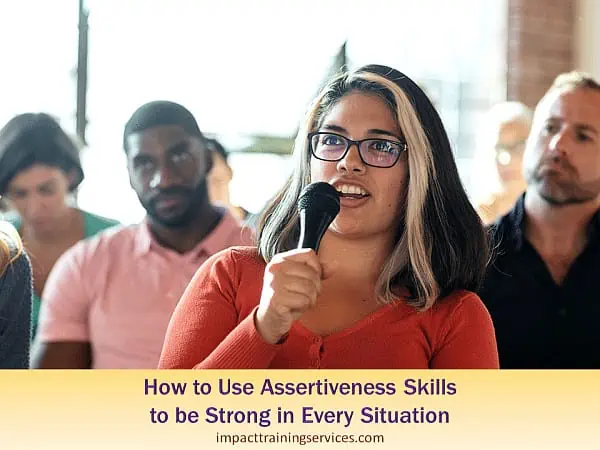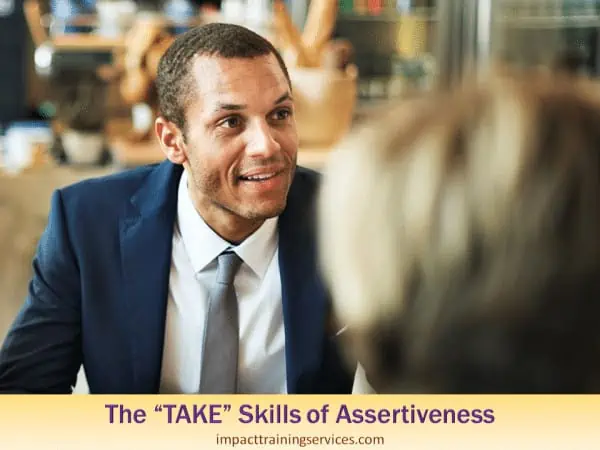Last Updated on April 14, 2024 by Lorna Barrow
For a long time in my life, I was completely unaware that there was any other way to behave except passive or aggressive. Assertiveness skills were not part of my vocabulary or my life.
Strange…I know.
But my mother was horribly aggressive. To the point where it was embarrassing. And as the first born, I was very often the target of much of her aggression.
Naturally, this made me very passive. I was shy and afraid to speak my mind, afraid to stand up for myself and most of the time, afraid even to be noticed.
But when I turn 25, I finally decided that if I was ever going to live life on my terms, something had to change.
It was then I discovered assertiveness.
And what I found most exciting about the discovery, was that assertiveness was actually a skill. One that I could use to build my confidence and self-esteem, enhance my personal and professional development and change my life.
So today, I’m taking another deep dive into assertiveness skills.
Why?
Undoubtedly, being able to communicate effectively is one of the most important business skills you can have. Unfortunately, it is the one you’re most likely to take for granted, to your own detriment.
But when you understand and can depend on key assertiveness skills to communicate powerfully, what happens?
Your influence as a small business leader increases inside and outside of your business. When this happens, you’re confident and strong in every situation, regardless of the outcome. This is not only good for you, it’s also good for your business.
So if you stay with me all the way to the end of this post, here’s what you’ll get:
1. A comprehensive definition of assertiveness
2. Examples of important instances when assertiveness skills matter
3. How to use the “GIVE” skills of assertiveness in communication
4. How to make the “TAKE” skills of assertiveness work for you
5. An immediate boost in your confidence and influence when you apply what you learn
Now if you’re ready, this is where your assertiveness training begins…
What Is The Meaning of Assertiveness
Assertiveness is expressing your thoughts, feelings, needs or rights in a direct, honest and appropriate manner, without undue anxiety. At the same time, you accept when others express theirs, without reacting in ways that deny them the right to their thoughts and feelings.
Right away, you will notice that to be truly assertive, you will have to develop “GIVE” and “TAKE” skills. Well, you are in luck. I’ll explain these later in this post so that you can begin using them at once.
But right now, let’s look at the 3 key words in the definition – direct, honest and appropriate.
Direct: This is how you speak to the matter at hand without “beating around the bush”. You are clearly focused and non-judgemental. Neither do you adjust your message to suit a particular circumstance or manipulate a person or process.
Honest: When your words express how you feel, your gestures support your words and together they communicate a single message, you’re being honest.
Appropriate: When your behaviour is appropriate, it recognises the rights and feelings of others as well as your own. You also make sure that the timing and place is right and you choose your carefully.
So you see, being appropriate in your communication and interaction, prevents you from using “direct” and “honest” to be mean and spiteful or anything but assertive.
Assertiveness is more than words
I remember as a child my grandmother controlled us with what we secretly called “the look”. And it was so much more powerful than any of the more “muscular” words she could use.
Just like my granny, when you’re being assertive, your message is conveyed through a variety of channels apart from words. These include eye contact, body language, facial expression, tone of voice, etc.
But more importantly, you have to be aware of the messages these non-verbal clues send about what you’re feeling. For example, they convey such messages as:
- Status – whether you feel superior, inferior or equal to the person you are speaking to
- Liking – the extent to which you like or dislike the other person.
- Response level – the amount of reaction the other person arouses in you.
The important thing you must note is, any disconnect between your words and your non-verbal messages is the chief clue that your message is not honest.
When this is the case, your listeners will most likely do one of two things. They will either take the unspoken message as the “real” message, or react negatively to the entire message by rejecting, ignoring, blocking or confronting you.
Assertiveness is NOT…
Getting what you want in every situation. Oh no! This is not one of the goals of assertiveness.
As a matter of fact, it is the surest way to deny others their rights and their input. If you do, you’ll find you block the flow of good ideas, forcing yourself to make decisions based on inadequate, incorrect or even distorted data.
Why Use Assertiveness Skills
Your ultimate goal should be to reach a place where being assertive is your default position. In addition, there are some situations in business when using assertiveness techniques can definitely work for you.
Here are some examples:
1. To negate certain intimidating tactics
At some point, you will find yourself on the receiving end of certain intimidating tactics. This behaviour can come from individuals or even organisations who behave as though you have no right to your opinions, especially given your size.
These tactics can take any of the following forms:
- Nullifying: This is when your message is completely invalidated. It’s like what you remember did not happen; what you say does not count. “We don’t need your input, but thanks very much”.
- Isolating: You are invalidated. You are forgotten or ignored. Others pretend you do not exist by consistently ignoring your thoughts, opinions and or your ideas. You may even be excluded from certain activities that affect you or your business.
- Undermining: Others create the impression that your motives, your actions or your opinions are questionable. This can eventually undermine your business and affect your revenue.
However, believing firmly in your rights, and responding with assertive rather than aggressive or passive behaviour, will help you counteract any of these intimidating tactics.
2. To keep the communication process going
This is particularly important especially in your role as a small business leader.
You cannot solve problems effectively or make sound decisions with inadequate or incorrect information.
By using assertiveness in leadership, you can keep the communication lines open so that new information, honest thoughts and feelings can flow in both directions.
In this way, you don’t have to coerce, intimidate or “con” others into accepting your position.
3. To build mutual respect
At some point, you will find yourself having to deal with individuals, inside or outside your business, who suffer from low self-esteem.
The problem here is, these people will tend to protect themselves from further harm by playing it safe in their approach to working with you.
This could mean they are likely to set or accept unchallenging goals, rely on routine rules or procedures and offer no creative thinking or ideas.
Unfortunately, this safe route leads to suppression of honest, direct communication which is so necessary for you to make good decisions.
In this case, assertiveness skills will help you to build a base of mutual trust and respect with your employees and business colleagues. These skills will provide you with the courage and confidence to initiate meaningful activities in response to this unproductive behaviour.
The Key Assertiveness Skills You Should Have
You will remember that earlier when I was defining assertiveness, I told you that you will have to develop 2 type of skills, namely GIVE and TAKE. Let’s look at them now.
The GIVE Skills of Assertiveness
Assertiveness ‘give” skills are those which originate with the communicator and are then shared with an audience. This is where good public speaking skills are invaluable.
Here are the key “GIVE” or sharing skills you should master:
1. Giving Information
When you’re giving information, especially in your leadership role, here are the communication steps you want to follow:
- Be direct
Give information as just that – straight facts with no bias, no overtones or undertones of what you want the person to do with the information.
- Be descriptive
The more details you can give the better. When statements are too general, your listener may not be sure how to interpret them and may not check with you for clarification.
- Show no immediate bias
If you start from a biased perspective, it blocks a full and free exploration of the issue and weakens the critical feedback you need.
- Do not be too quick to give advice
If you belong to that group of impatient managers or leaders who are quick to offer advice or provide solutions, stop it! This leads to and perpetuates undesirable dependence on you. Instead, allow your team to think through and attempt to solve the problems first. You may be surprised by what they come up with.
2. Stating your needs/expectations
Stating what you want, in a way that people can understand and act on your request, requires a great deal of clarity. Approaching the task in the following manner will help you.
- Know what you want
Focus on what you want out of the situation. Be specific. Is it a request? Fast action? Commitment? When you are clearly focused it is extremely difficult for others to manipulate you or take you off your goal.
- Do not make assumptions
Some managers seem to think that others can accurately read their minds (possible only if you have nothing there!) So they give vague and unclear instructions and assume that their staff understand them. Don’t assume that you are understood, get the feedback that lets you know that you definitely are.
- Invite Feedback
After you have stated your needs as clearly as possible, invite feedback. You need to know that your request has been heard, acknowledged, accepted as is or can be discussed for possible revision. When you do, you don’t have to take positions like “Common sense should tell you…” or “But you must know that I need the Information for the meeting…”
- Communicate clearly
Don’t use language that’s above the level of your audience and be sure to use examples and illustrations they can relate to. It was you who decided what you want, therefore it must mean something to you. Don’t weaken its worth by the language you choose.
3. Giving your decision
Coming to a decision and sharing it is seldom easy. But having a logical approach to decision-making and using assertiveness skills to share it will go a long way towards having it accepted.
So here’s an approach you can use.
- Be clear about your position
To help you make a good decision, consider all aspects of the issue. You must consider your position, the position of the persons affected by your decision and the needs of your business. Taking this approach will make it much easier to maintain an assertive stance, should you meet resistance. On the other hand, if you’re undecided, you will be a prime target for manipulation.
- State your decision clearly
When you have eventually made your decision, use terms like “I will” or “I will not” or “I have decided to” or “I have decided not to” to share it. If you are uncertain about your decision, address this issue directly. Ask for clarification or more time to decide. When you have made your final decision, be sure to let your team know as soon as possible.
- Communicate your decision concisely
It is fairly common for you to feel stressed when responding to a request, especially when your answer is going to be “no”. This discomfort tends to make you long-winded. So be brief but not sharp. Just remember, you don’t have to apologise for a refusal. When the answer is “yes” say so without tagging on conditions. Making your “yes” conditional, undermines your positive decision and make the receiver resentful.
- Be firm and stick to your position
When you are faced with resistance or manipulative argument, uphold your original position. Just because your answer is not popular does not mean it is not valid. However, sticking to your position does not mean that you do not have the right to change your mind. Especially if you receive new and relevant information.
4. Giving criticisms or compliments
Giving criticisms and compliments may appear to require 2 different approaches. However they often depend on similar approaches.
Here’s an assertive way that keeps the process professional.
- Describe behaviour with examples
Focus clearly on the behaviour that is acceptable or unacceptable. For example: “I like the way you dealt with that farmer by showing him how to use our pesticides” (compliment). “I can’t concentrate on Mark’s report when you two keep talking between yourselves.” (criticism). On the other hand, avoid using comparisons (I wish everyone was like you) or labelling (you’re lazy, unreliable, terrific, super).
- Clarify the impact
State how the behaviour affect you and the other persons involved. (I can’t concentrate when you two…) By describing the consequences you lessen the “blaming” attitude or implied threats often associated with criticisms. Remember that clarifying the impact is important for helping people to make sound decisions about their behaviour.
- Choose the time carefully
Good timing is essential for giving criticisms or compliments. People are inclined to “close down” early when they are stressed. When they do, they will hear neither the criticisms or praise, however effectively they are delivered. Learning to praise or criticise at a time when other people can take it in and move on, is a clear sign of how assertive you are.
- Don’t go overboard with the criticism
Most people can only take in a limited amount of praise or criticisms at any time. In giving criticisms isolate the problem and deal only with that. Do not bring up old history. It will not end well, especially for you.
- Don’t use compliments to manipulate
Make sure your compliment is an honest, direct, appropriate expression of your pleasure or admiration, when and where it is due. Do not use compliments to mask hidden agendas that you cannot deal with directly. E.g. “Your mathematical ability is great! (one breath). Could you do my tax returns for me?” (next breath).
The Take Skills of Assertiveness
It’s important that you accept or “TAKE” what others say without reacting in ways that deny then the rights to their thoughts or feelings. Actually, it is just as important as how you “GIVE” your assertive messages. after all, assertive behaviour is interactive.
So let’s look at some “TAKE’ skills you want to have in your toolbox.
1. Seeking information
Information is critical to most every decision you make. But not just any old information, you want relevant and meaningful information.
Following the process below will not only demonstrate your assertiveness skills but will get you the information you really want.
- Do your homework
Before you ask for information make sure you are up to date on the issues concerning the person or situation. Doing this prevents you from asking questions that appear to cover old ground or are way off base. Asking such questions leads others to think you don’t know what’s going on around you.
- Ask the right questions
You are asking questions because you want others to share their feelings, contribute facts, state their views and needs. Asking the right questions will determine the amount and quality of the information you receive.
2. Take in content
When you can “take in” content effectively, it really means that you understand what is being said to you and you can evaluate it and come to an objective conclusion.
Here’s a good way to “take in” content.
- Listen without judgement
Listen to what is being said without coming to an early evaluation, jumping to a quick conclusion or rushing in with solutions or decisions. To come to the most objective conclusions or decisions, you need the best possible accumulation of facts, feelings, views and needs. The best way to acquire these is by listening with an open mind.
- Interpret information you hear
When you are assertive in taking in content, you need to demonstrate that you understand what you have heard before you act on it. The best way to do this is to reflect back your understanding of what you have heard and get feedback that you are correct.
3. Take in feelings
- Acknowledge the feelings of the speaker
When someone is an emotional state, your first priority is to listen to that person and try to understand his or her feelings. The key to this is to acknowledge those feelings. Acknowledgment is not offering a solution, neither is it agreement nor disagreement. It is just hearing the person. In essence, it’s “taking in” without “taking over”.
- Interpret the emotion and label the feelings
Interpret the emotional tone you have heard and give the feelings a label. E.g: disappointment, anger, frustration. However, do not make general statements like “I understand how you feel.” You really don’t.
- Do not avoid acknowledging feelings
Many business owners and managers believe that the workplace is not the place for any display of strong emotions. This often results in “Leave your emotions at home please!” and similar attitudes. Be assertive and acknowledge what your employees are going through before they become bigger problems for you.
4. Take in criticisms
- Don’t react, explore it
You need all the criticisms you can get – if it is relevant to your functioning as a competent, effective leader. Unfortunately, most of us have conditioned ourselves to react to criticism by denial or counter-attack. Don’t react like that. Respond by exploring the issues which their criticisms raise.
- Seek suggestions
After you have explored the criticisms, it is alright to seek suggestions or ask for alternatives. Others may have valuable ideas for improvements or to increase your effectiveness. If you are open and responsive, you can grow from the feedback. This is one of your best assertiveness skills.
Your Next “Assertiveness Skills” Steps
Congratulations!
You’ve taken a deep dive into assertiveness skills with me. And your life will never be the same.
You now have no doubt that using assertiveness skills will increase your self-confidence. But that’s not all. It also leads to enriched relationships, and releases you from old patterns of behaviour.
Why would you not use these skills as your default communication approach?
Just decide which of your skills set is weaker – GIVE or TAKE.
Then begin working on that group first and follow it up with the other one.
Always remember that mastering assertiveness skills places you in control of yourself and helps you to be strong in every situation.






